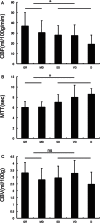Early Cerebral Circulation Disturbance in Patients Suffering from Severe Traumatic Brain Injury (TBI): A Xenon CT and Perfusion CT Study
- PMID: 27356957
- PMCID: PMC4987450
- DOI: 10.2176/nmc.oa.2015-0341
Early Cerebral Circulation Disturbance in Patients Suffering from Severe Traumatic Brain Injury (TBI): A Xenon CT and Perfusion CT Study
Abstract
Traumatic brain injury (TBI) is widely known to cause dynamic changes in cerebral blood flow (CBF). Ischemia is a common and deleterious secondary injury following TBI. Detecting early ischemia in TBI patients is important to prevent further advancement and deterioration of the brain tissue. The purpose of this study was to clarify the cerebral circulatory disturbance during the early phase and whether it can be used to predict patient outcome. A total of 90 patients with TBI underwent a xenon-computed tomography (Xe-CT) and subsequently perfusion CT to evaluate the cerebral circulation on days 1-3. We measured CBF using Xe-CT and mean transit time (MTT: the width between two inflection points [maximum upward slope and maximum downward slope from inflow to outflow of the contrast agent]) using perfusion CT and calculated the cerebral blood volume (CBV) using the AZ-7000W98 computer system. The relationships of the hemodynamic parameters CBF, MTT, and CBV to the Glasgow Coma Scale (GCS) score and the Glasgow Outcome Scale (GOS) score were examined. There were no significant differences in CBF, MTT, and CBV among GCS3-4, GCS5-6, and GCS7-8 groups. The patients with a favorable outcome (GR and MD) had significantly higher CBF and lower MTT than those with an unfavorable one (SD, VS, or D). The discriminant analysis of these parameters could predict patient outcome with a probability of 70.6%. During the early phase, CBF reduction and MTT prolongation might influence the clinical outcome of TBI. These parameters are helpful for evaluating the severity of cerebral circulatory disturbance and predicting the outcome of TBI patients.
Figures






Similar articles
-
Early cerebral circulatory disturbance in patients suffering subarachnoid hemorrhage prior to the delayed cerebral vasospasm stage: xenon computed tomography and perfusion computed tomography study.Neurol Med Chir (Tokyo). 2012;52(7):488-94. doi: 10.2176/nmc.52.488. Neurol Med Chir (Tokyo). 2012. PMID: 22850497 Clinical Trial.
-
Early cerebral circulation disturbance in patients suffering from different types of severe traumatic brain injury: a xenon CT and perfusion CT study.Acta Neurochir Suppl. 2013;118:259-63. doi: 10.1007/978-3-7091-1434-6_49. Acta Neurochir Suppl. 2013. PMID: 23564144
-
Quantitative cerebral blood flow using xenon-enhanced CT after decompressive craniectomy in traumatic brain injury.J Neurosurg. 2018 Jul;129(1):241-246. doi: 10.3171/2017.4.JNS163036. Epub 2017 Oct 13. J Neurosurg. 2018. PMID: 29027859
-
Imaging of cerebral blood flow in patients with severe traumatic brain injury in the neurointensive care.Front Neurol. 2014 Jul 7;5:114. doi: 10.3389/fneur.2014.00114. eCollection 2014. Front Neurol. 2014. PMID: 25071702 Free PMC article. Review.
-
Perfusion Imaging of Traumatic Brain Injury.Neuroimaging Clin N Am. 2023 May;33(2):315-324. doi: 10.1016/j.nic.2023.01.006. Neuroimaging Clin N Am. 2023. PMID: 36965948 Review.
Cited by
-
Vascularization, Innervation, and Inflammation: Pathways Connecting the Heart-Brain Axis and Implications in a Clinical Setting.Biomedicines. 2025 Jan 13;13(1):171. doi: 10.3390/biomedicines13010171. Biomedicines. 2025. PMID: 39857755 Free PMC article. Review.
-
Traumatic Brain Injury and Alzheimer's Disease: A Shared Neurovascular Hypothesis.Neurosci Insights. 2025 Mar 20;20:26331055251323292. doi: 10.1177/26331055251323292. eCollection 2025. Neurosci Insights. 2025. PMID: 40124421 Free PMC article. Review.
-
Using computerized tomography perfusion to measure cerebral hemodynamics following treatment of traumatic brain injury in rabbits.Exp Ther Med. 2019 Sep;18(3):2104-2110. doi: 10.3892/etm.2019.7785. Epub 2019 Jul 17. Exp Ther Med. 2019. PMID: 31410165 Free PMC article.
-
Perfusion Imaging in Acute Traumatic Brain Injury.Neuroimaging Clin N Am. 2018 Feb;28(1):55-65. doi: 10.1016/j.nic.2017.09.002. Epub 2017 Oct 23. Neuroimaging Clin N Am. 2018. PMID: 29157853 Free PMC article. Review.
-
Consideration of the Intracranial Pressure Threshold Value for the Initiation of Traumatic Brain Injury Treatment: A Xenon CT and Perfusion CT Study.Neurocrit Care. 2017 Dec;27(3):308-315. doi: 10.1007/s12028-017-0432-5. Neurocrit Care. 2017. PMID: 28762185
References
-
- Bouma GJ, Muizelaar JP: Evaluation of regional cerebral blood flow on acute head injury by stable xenon-enhanced computerized tomography. Acta Neurochir Suppl 59: 34– 40, 1993. - PubMed
-
- Bouma GJ, Muizelaar JP, Choi SC, Newlon PG, Young HF: Cerebral circulation and metabolism after severe traumatic brain injury: the elusive role of ischemia. J Neurosurg 75: 685– 693, 1991. - PubMed
-
- Bouma GJ, Muizelaar JP, Stringer WA, Choi SC, Fatouros P, Young HF: Ultra-early evaluation of regional cerebral blood flow in severely head-injured patients using xenon-enhanced computerized tomography. J Neurosurg 77: 360– 368, 1992. - PubMed
-
- Jaggi JL, Orbist WD, Gennarelli TA, Langfitt TW: Relationship of early cerebral blood flow and metabolism to outocome in acute head injury. J Neurosurg 72: 176– 182, 1990. - PubMed
-
- Orbist WD, Gennarelli TA, Segawa H, Dolinskas CA, Langfitt TW: Relation of cerebral blood flow to neurological status and outcome in head injured patients. J Neurosurg 51: 292– 300, 1979. - PubMed
MeSH terms
Substances
LinkOut - more resources
Full Text Sources
Other Literature Sources
Medical

